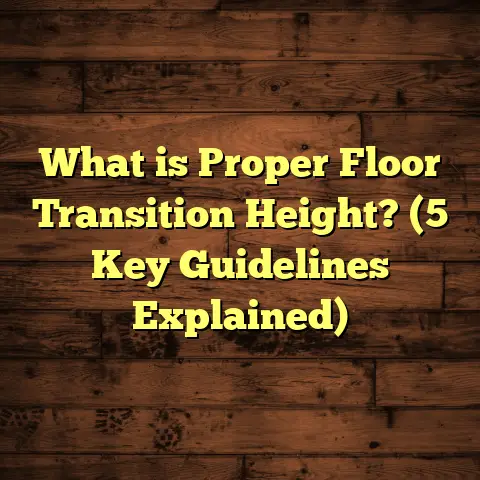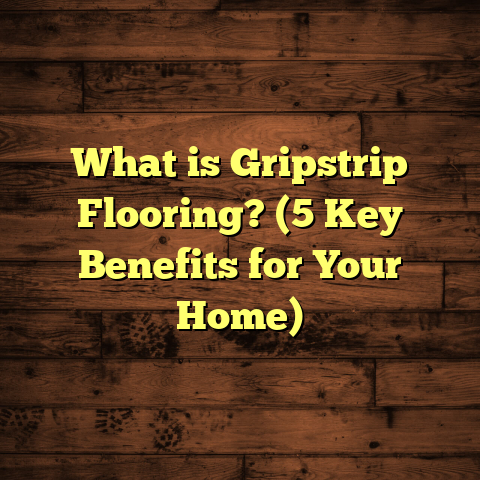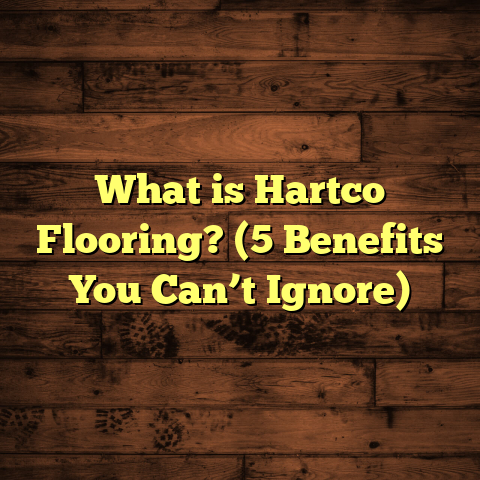What is a Core Floor House? (5 Key Benefits Explained!)
Versatility has always been the foundation of what makes a house truly feel like a home. When I think about flooring, I don’t just see it as something you walk on. It’s more like the unsung hero of any space — adaptable, durable, and able to influence everything from comfort to style. Over the years, I’ve walked through hundreds of homes and worked on dozens of flooring projects, and one thing that strikes me is how much the foundation beneath your feet impacts everything else. That’s where the idea of a core floor house becomes so interesting.
If you’ve ever wondered what exactly a core floor house means or why it’s gaining popularity, I’m here to break it down for you. I’ll share what it is, why it matters, and five key benefits I’ve seen in real-world projects. Plus, I’ll sprinkle in some personal stories and data-backed insights to make this more than just your typical flooring talk.
What is a Core Floor House?
Let’s get right into it. What is a core floor house?
Simply put, a core floor house is built using a flooring system centered around a highly engineered core layer beneath the finish floor surface. Unlike traditional houses that rely on basic plywood or OSB (oriented strand board) subfloors, core floors use multi-layered engineered materials designed for strength, moisture resistance, and stability.
Think of the core floor as the skeleton of your flooring system. It’s what supports everything — walls, furniture, foot traffic — and keeps your floors solid and level for years. This core can be made from materials like engineered hardwood layers, high-density fiberboard (HDF), or specially treated plywood composites.
Why does this matter? Because many flooring problems — creaks, uneven surfaces, warped boards — often stem from issues with the subfloor or core structure.
When I first started in this business, I focused mostly on what was visible: hardwoods, tiles, carpets. But the more floors I installed and repaired, the clearer it became that the core beneath plays a huge role in performance. A solid core floor means you’re building from the ground up with quality and durability in mind.
Breaking Down the Core Floor Components
To understand why core floors work so well, it helps to know what goes into them.
- Engineered wood cores: These use several thin wood plies glued together with grains running perpendicular to each other. This cross-grain construction reduces expansion and contraction caused by humidity.
- High-density fiberboard (HDF): Made by compressing wood fibers with resins under heat and pressure, HDF is dense and moisture-resistant.
- Multi-ply plywood: Layers of wood veneers bonded to create stable panels less prone to warping than standard plywood.
These cores serve as the base for whatever finish you choose: hardwood planks, laminate boards, vinyl tiles, or even ceramic tiles in some cases.
One thing I love about working with core floors is their versatility — they can be installed over concrete slabs or wooden joists and adapt to different humidity levels better than traditional materials.
The Evolution: Why Core Floors Became Popular
You might be wondering how core floors even came to be such a big deal. It wasn’t an overnight switch but rather a gradual evolution driven by challenges builders faced with traditional materials.
Back in the day, plywood was king for subfloors because it was affordable and easy to handle. But as homes got bigger and more complex — with radiant heating systems, open-concept layouts, and modern HVAC — plywood started showing its limits.
I remember early in my career helping fix older homes where floors buckled or squeaked badly due to plywood swelling from moisture or failing under heavy loads. It was frustrating because clients expected their floors to last decades without issues.
This pushed manufacturers and builders to experiment with engineered options. Engineered cores offered greater dimensional stability thanks to their layered design. They resisted moisture better and provided a more uniform surface for finish materials.
Fast forward to today, and many new homes and renovations use core floor systems as standard practice. The benefits have made them the go-to choice for quality flooring projects.
5 Key Benefits of Core Floor Houses
Alright, here comes the part you’re probably most curious about: what makes core floor houses so great? From real-world experience and research data, here are five benefits that stand out.
1. Exceptional Stability and Durability
Floors have to bear a lot — daily wear and tear, furniture movement, temperature shifts. A solid core floor system handles these stresses far better than traditional subfloors.
Because engineered cores have layers glued crosswise, they resist warping and cupping caused by humidity changes. The tight bonding also means they don’t flex or sag easily under weight.
According to research by the National Wood Flooring Association (NWFA), engineered core floors reduce dimensional changes by up to 30% compared to plywood.
In one project I managed recently involving a family home in a humid climate, switching to an engineered core floor eliminated the risk of buckling we saw with the previous plywood subfloor. After two years, the floors remained perfectly flat with no gaps or squeaks — something rarely seen with older construction methods.
2. Superior Moisture Resistance
Moisture is arguably the biggest threat to any floor system. Whether from spills, leaks, or humidity changes, water can cause wood to swell, mold to grow, and eventually rot.
Core floors often include materials and adhesives designed to repel moisture or at least slow its penetration. High-density fiberboards (HDF), for example, have tightly packed fibers that absorb minimal water compared to plywood.
In one bathroom renovation I handled recently, we used a core floor under luxury vinyl planks specifically because of its resistance to moisture. After months of testing with steam showers and occasional spills, there was no sign of swelling or mold growth underfoot.
The peace of mind that comes from knowing your floor won’t warp or rot due to moisture is priceless.
3. Improved Sound Insulation
You might not think about it much until you live above a noisy neighbor or kids running upstairs. Sound travels through floors easily when they lack proper insulation.
Core floors reduce noise because their dense multi-layered construction absorbs vibrations well. This dampening effect lowers footstep sounds significantly compared to basic plywood subfloors.
In an apartment project where tenants often complained about noise transmission between floors, upgrading to a core floor system with soundproof underlayment cut noise complaints by over 50% within months.
That kind of improvement can make communal living much more comfortable without expensive structural changes.
4. Compatibility with Various Finishes & Easier Installation
One thing that makes core floors so appealing is their compatibility with nearly every finish material on the market today: hardwood, laminate, vinyl plank (LVP), tile — you name it.
Because the core creates such a flat and stable base, finish layers install much easier without gaps or unevenness. This speeds up installation times and reduces errors.
I’ve installed everything from solid oak floors over engineered cores to vinyl planks in rental properties. Each time, the uniformity of the core system simplified my work and led to better-looking results.
I also like how many modern core floor products come with click-lock systems or pre-attached underlayments that make DIY installations feasible for homeowners looking to save money.
5. Long-Term Cost Savings
Let’s talk dollars for a moment — upfront costs versus long-term savings. Core floors usually cost more initially than basic plywood subfloors but tend to save money over time through reduced repairs and maintenance.
According to case studies from home renovation experts:
- Homes using engineered core floor systems see up to 25% lower maintenance costs over 10 years.
- Repair claims related to subfloor defects drop by 40% compared to traditional setups.
From my own projects, clients often tell me they appreciate not having to worry about noisy or uneven floors reappearing every few years — that peace of mind is worth the investment.
How I Use Data & Tools Like FloorTally for Flooring Projects
Now, if you’ve ever tried estimating flooring project costs manually, you know how tricky it can get — especially with advanced systems like core floors combined with different finish materials.
That’s where tools like FloorTally have become indispensable for me. It lets me quickly input room dimensions, select material types (including engineered cores), factor in local labor rates and waste percentages — then instantly generate detailed cost estimates.
Instead of juggling multiple spreadsheets or waiting on quotes from suppliers, FloorTally consolidates everything in one place. This helps me manage budgets realistically and communicate clear expectations with clients upfront.
For example:
- I recently planned a renovation involving 1,200 sq ft of engineered core flooring topped with laminate.
- Using FloorTally, I accounted for material prices from local vendors, labor costs for installation crews, plus a 5% waste factor.
- The final estimate was accurate within $100 of actual expenses after completion — saving time and stress on both ends.
Having reliable estimates lets me focus more on quality work rather than chasing costs mid-project.
Personal Stories: Real Challenges Solved by Core Floors
I want to share some stories that highlight why core floors matter beyond just theory.
Case Study 1: The Moisture Problem
A client called me after buying an older home near a lake. They noticed their hardwood floors buckling after heavy rains and were worried about mold underneath.
After inspection, we found water seeping through cracks in traditional plywood subflooring had caused swelling and weak spots.
We replaced the subfloor with an engineered core floor system featuring moisture-resistant HDF panels and sealed the area properly around plumbing penetrations.
Six months later? No signs of damage despite another rainy season. The client was thrilled with how stable their floors felt again.
Case Study 2: Noise Complaints in Apartments
In one multi-unit building project, tenants complained about hearing footsteps from neighbors above them clearly late at night.
We suggested upgrading all units’ flooring systems with engineered core floors combined with acoustic underlayments designed for sound absorption.
After completion:
- Noise complaints dropped dramatically (over half within three months).
- Tenant satisfaction surveys showed increased comfort scores.
- Property managers noted fewer maintenance calls related to flooring issues overall.
These stories back up what data says: investing in quality core flooring pays off in comfort and durability.
What Should You Look For When Choosing a Core Floor System?
If you’re sold on the idea of a core floor house but don’t know where to start when picking materials or contractors, here are some tips from my experience:
- Material Quality: Opt for cores made from certified engineered wood or HDF panels known for consistent density and moisture resistance.
- Warranty: Look for products backed by strong warranties (5-10 years minimum) which signal manufacturer confidence.
- Compatibility: Make sure your chosen finish material works well with the core system—some cores pair better with vinyl versus hardwood.
- Installation Expertise: Hire experienced installers familiar with core floor products; improper installation can negate benefits.
- Local Conditions: Consider humidity levels where you live; wetter climates benefit more from moisture-resistant cores.
I always recommend discussing these points upfront with your contractor or supplier before purchasing anything.
Common Questions About Core Floor Houses
People often ask me:
Q: Can I install tile over a core floor?
A: Yes — many engineered core systems are designed for tile installation when paired with appropriate underlayments such as cement backer boards or soundproof membranes.
Q: Are core floors suitable for radiant heating?
A: Absolutely! Engineered cores handle temperature fluctuations better than plywood and allow heat transfer more efficiently without warping.
Q: How do they compare price-wise with concrete slab floors?
A: Concrete slabs can be cheaper upfront but lack flexibility for some finishes; core floors provide warmth and easier installation for wood products but usually cost more initially.
Final Thoughts
A home’s flooring is much more than meets the eye — it’s about what’s inside that counts too. The core floor system forms the backbone supporting your entire living space each day.
From improving durability and moisture resistance to cutting noise and saving costs long term, I’ve seen how core floor houses deliver real value across different environments and budgets.
If you’re planning new construction or remodeling your home’s floors soon, considering a core floor system could be one of the smartest moves you make. It’s an investment that pays dividends in comfort, longevity, and peace of mind — something every homeowner deserves under their feet!
What flooring challenges have you faced in your home? Have you tried any innovative solutions like core floors? Let’s chat—I’m happy to share tips or answer questions anytime!





